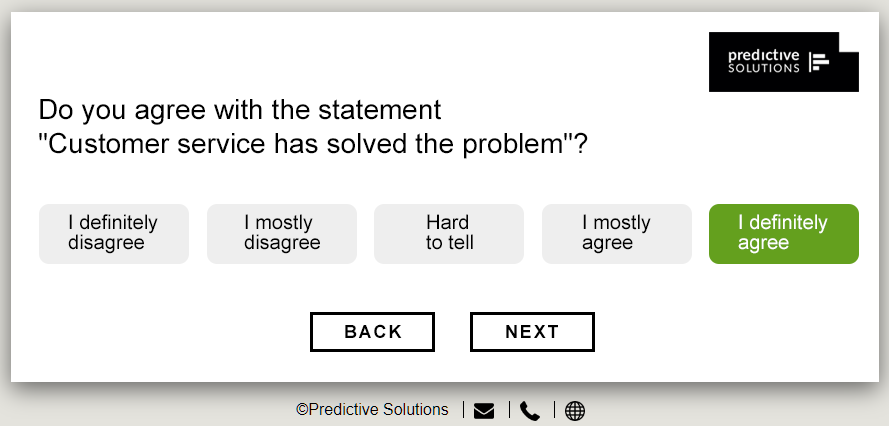By RAFAŁ WAŚKO (Predictive Solutions)
Customer Effort Score (CES), along with Net Promoter Score (NPS), and Customer Satisfaction (CSAT), is one of the key indicators related to clients’ satisfaction. All these three indicators are intended to understand the moods of customers, but each of them focuses on a different aspect of their experience.
WHAT IS CES?
In 2010, the Harvard Business Review published the article entitled “Stop Trying to Delight Your Customers”[1], in which the researchers tried to answer the questions:
- What is the importance of customer service in terms of their loyalty?
- What activities related to customer service increase their loyalty?
- Can businesses promote loyalty without incurring customer service costs?
The study concluded that the effort that consumers put into interacting with a brand directly affects their loyalty and possible further purchases. To a great extent, customers who have reported any issues and have struggled to solve them would resign from the company’s offer or from the given product more often. Such disloyal customers will probably cost the company more, since they could disseminate negative opinions and also stop buying. Therefore, it is important to monitor whether or not the customer can easily solve their problems and the purchasing process itself runs without much difficulty. For this purpose, Customer Effort Score has been created.
Customer Effort Score (CES) is an indicator which measures the effort a client puts into contacts with the company, e.g., when purchasing, solving customer service issues, or other interactions. The basic question in Customer Effort Score may have the following form:
How much effort did you have to put into solving your issue on a scale of from 1 (very low effort) to 5 (very high effort).
THE SCORING SCALES IN CES-FRAGEN
The form the question takes is usually adapted to the interaction in which the survey is being completed by a client. The customer’s effort put into solving the issue may be evaluated by different scales.
- Likert scale – the client may respond using a scale ranging from 1 to 7 or from 1 to 5. For the 5-grade scale, particular grades can have the following values:
1 -I definitely disagree
2 -I mostly disagree
3 -Hard to tell
4 -I mostly agree.
5 -I definitely agree
If the survey must be completed by the customers on their own, the answers may be colored, to make them visually more intuitive for the respondents (e.g. green “I definitely agree”, red “I definitely disagree”).

Figure 1. Sample question with colored answers prepared in PS HORIZON PRO
- 1-10 grade scale – customers answer on a scale of from 1 to 10. In general, the 7-10 answers indicate positive responses (for example, if we ask the clients how easy it was to do something). However, if the question is about assessing effort, the answers from 1 to 3 usually are associated with positive results representing low effort.
- Evaluation by means of emoticons – a relatively easy assessment method, useful for many questions concerning minor aspects of a product or service. Such an evaluation form also makes it easier for the respondents to respond quickly and intuitively. In general, the answers used here are graphics presenting happy, neutral, and unhappy faces, where the happy face usually means that the effort made was not large, or the process of handling the notification proceeded without greater problems.

Figure 2. Sample question with answers in the form of emoticons prepared in PS HORIZON PRO
HOW TO CALCULATE CES
If a numerical scale is used, CES is calculated as the quotient of the sum of all the individual results received from customers, and the number of the customers who provided their answer. The higher the CES the better.


WHEN TO SEND CES QUESTIONNAIRES
Measuring CES at the right moments plays an important role in evaluating customer satisfaction. In general, the interactions with customers may be divided into three critical situations, in which CES questionnaires should be sent.
- The interactions which have led to a purchase
A good occasion to collect feedback on what improvements to make is sending CES questionnaires after clients interacted with a product/service or the sales team, and this interaction resulted in a purchase. In such a situation, it is good to ask the customers whether or not they’ve encountered any issues when buying the products or services. Another situation when it’s good to send a CES questionnaire to a customer is their registration for a free trial version, or ending the use of a product’s demo version.
- Interaction with customer service
Sending a CES questionnaire after contact is made with the customer service department makes it possible to learn quickly how efficient the technical assistance team is, and whether or not any changes are required to increase the general efficiency. In this case, the survey will make it possible to obtain information as to what the problem was, and whether it was solved.
- Other interaction between a customer and the company
A CES questionnaire may also be sent after interactions which may cause negative experiences for customers. This could be, e.g., related to the launch of a new function in a piece of software. Such a study will help specify how the function was welcomed, were there any issues, etc. It is important that the question relates to this interaction, and is sent to the customer after its conclusion. This way the customer can express a “fresh” opinion after using the service.
SUMMARY
Customer Effort Score can be considered a good measure of customers’ loyalty that can be easy to implement and track over time. It also makes it possible to determine areas which require improvements in order to upgrade customer service.
Since the expectations of customers continuously evolve, it is necessary to consistently observe the results and study the general satisfaction of the customers. Unfortunately, CES does not always provide a complete picture, and it may be a good solution to use it in combination with NPS, e.g., the client may be a promoter of the brand, but has had difficulties with submitting a complaint. When we look at the CES result alone, we may wrongly conclude that the customer is not loyal, when in actual fact their NPS result is very high, and they are a fan of the brand.
Activities intended to decrease a customer’s effort in solving potential difficulties will make it possible to keep an existing customer, but may also help acquire new customers at no additional cost. A positive opinion from a customer which is shared with others further helps build the positive image of the business, and increases the likelihood of acquiring new clients. It should be remembered that different satisfaction measures are only useful when any relevant feedback is translated into actions that supplement and streamline products or services.
[1] https://hbr.org/2010/07/stop-trying-to-delight-your-customers

